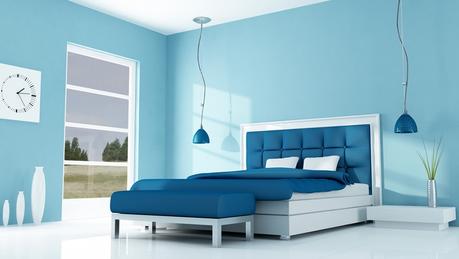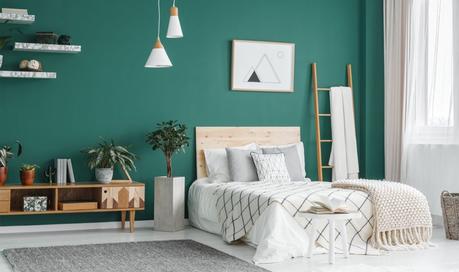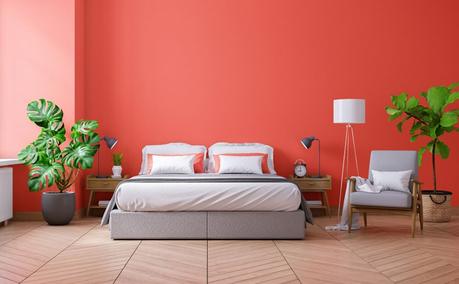The best and worse colors for sleep can be established by applying psychology and the effect of color on the brain. The colors in your bedroom have a significant influence on how you sleep and how well you sleep. It's not all just down to your mattress and pillow! The color of your bedroom walls, ceiling, bedding, and flooring all influence your quality of sleep. You can enhance that by choosing certain colors for your bedroom and avoiding others. Yes - avoiding others! This is because not all colors are good for promoting restful sleep: some can prevent it, and leave you tossing and turning all night!

Sleep is important for several reasons relating to your mental and physical health. It keeps your brain healthy and working properly. You wake up refreshed and perhaps with a solution to that problem you had last night. Without sufficient good quality sleep, your brain may not be as alert as it should, leading to the possibility of you making mistakes that could harm you, particularly when driving. The quality of your work will be lower than it should, particularly if it involves problem-solving. Sleep is particularly important for children. It enables a child's brain to develop properly and is also important to their growth and development. A lack of sleep will also likely affect your mood and the way you interact with others and handle difficult situations.
In short, sleep is important and you should take whatever steps you can to ensure you have high-quality sleep night after night. One way to help achieve that is to be aware of how color can affect sleep and apply that knowledge to your bedroom décor. There are other reasons for ensuring you have good quality sleep, and those above are merely a few examples. It is widely believed that certain colors can soothe and relax you, and lead to a restful high-quality sleep.
Table of Contents
How Your Bedroom Color Can Influence Sleep Quality
Blue: Blue is said to be a soothing and calming bedroom color, promoting tranquility and relaxation, leading to a restful, relaxing sleep. UK firm, Travelodge, carried out a study of bedroom décor and found that blue rooms promote the best quality of sleep. The color blue is picked up by the retina in each eye which, when sent to your brain, affects your circadian rhythm. This results in good sleep quality due to reduced blood pressure and heart rate. Many believe this to be the best color for sleeping.
Yellow: Yellow is another soothing color for the bedroom. It ranks second only to blue for good sleep quality. The color can give you a feeling of comfort and promotes relaxation. Variations of yellow encourage relaxation by stimulating the nervous system. Some believe that yellow should be used in small amounts in a bedroom, more as an accent color than used as the sole color. If the latter, then various shades of yellow should be used
Green: Bright greens, such as lime green, should be avoided. However, natural green shades are believed to promote positive energy, love, and reputation. Such effects on you tend to be calming and relaxing, which promotes a deep relaxing sleep to make you feel more rested and alive in the morning. Some people like a combination of yellow and green for a soothing, calming, and relaxing bedroom color scheme.

Orange: Orange is a warm and relaxing color and one of the best bedroom colors for sleep. Not only is it a warm color, but it is also believed to increase the oxygen supply to the brain, possessing definite sleep-enhancing properties. It helps you to relax your muscles and fall into a deep, quality sleep. Deeper oranges are more effective colors in your bedroom than bright oranges, though you can combine the two. Some believe orange to be unsuitable for a bedroom, much the same as red. However, if you use a deeper shade of orange then it can be very relaxing.
Silver: Silver is occasionally used as a bedroom shade, although those who use it say that it is a very soothing shade that helps them drift off into a deep sleep. There is a theory that the brain thinks that silver is like a dark moonlit night, and believes it is time for sleep. Note that silver is not the same as grey, but is shinier with metallic tones and highlights. Sleep quality in a silver bedroom is reported to be high by those who like this shade - or a combination of whites, greys, and black.
The Worst Bedroom Colors for Sleep
The above are generally agreed to be the best bedroom colors for sleep. You can decorate a bedroom and furnish it using just the one color, or a combination of those above. However, what colors should you avoid in your bedroom? What are the worse bedroom colors for sleep? It is generally agreed that the following colors should be avoided when decorating a bedroom.
Red: Red is the color of danger and warning. It is a passionate color that tends to quicken the pulse, increase your blood pressure, and keep you awake. You don't want these effects if you want to fall asleep. It will tend to keep you awake and should be avoided in the bedroom if you want a soothing effect. If you like red, then it could be used as an accent color in your bedroom, but not for large areas. However, many believe that red is the worst bedroom color for sleeping.

Brown: Apart from the fact that brown is not an attractive color for a bedroom, it is a gloomy color and imparts a sense of unease and unrest. Brown is not a good color for decorating a bedroom, and not only can it make people restive and uncomfortable, but it can also give you a feeling of depression.
Purple: Purple and lilac are stimulating colors that make it difficult to settle down and rest. They not only stimulate your imagination but also lead to nightmares and a poor quality of sleep. It's a very rich energizing color in all its nuances such as lilac, and it is certainly not a good color for a bedroom. Don't use purple if you want a good night's sleep - unless it's your favorite color of course, in which case it might suit you.
Using Grey as a Color for Sleep
Grey: Grey can be a very depressing color for a bedroom, and many include it in their list of colors to be avoided in a bedroom. However, if used correctly with imagination and a touch of white and some colorful accents, it can be one of the best bedroom colors for sleep. Some experts claim grey to be one of the worse colors for a bedroom, mainly due to its depressing appearance. However, this so-called depressing color can be calming, feminine, masculine, and conducive to good quality sleep. Combine it with soft pinks or baby blue with carefully placed lighting and the dreariness disappears. It tends to present a tranquil mood to a bedroom and is a more versatile color than most people would believe. According to Feng Shui, the best colors for a West and a Northwest area bedroom are grey and white.
Summary: Best and Worst Bedroom Colors for Sleep
Everybody has their own opinion of what the best colors are for their bedrooms. Psychologists look at this issue differently by using the brain's reaction to certain colors and shades to explain why some colors appear more peaceful, soothing, and relaxing than others. Unless you must have that red bedroom or paint the walls purple, it usually pays to follow the experts.
Experts don't always agree, however, and grey is an example of that. Some claim that greys are devoid of color (so is white!) and its drabness is depressing. However, more believe grey to be soothing and present a perception of soothing tranquility that helps you to sleep. That's the view we take and grey walls and carpets can offer you the opportunity to use your imagination with the use of accent colors such as light blue pillows and silvered floor mats or nightstands.
Our decisions regarding the best and worse colors for sleep and bedroom décor have been made based on a mixture of science and experience. It will be hard to go wrong if you select one of our best options, and even include some of the others as accents. The best colors for sleep are not subjective but established after careful study and the comments of those that use them.

